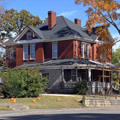The Highland and Virginia Park neighborhoods became a choice address for Bristol's elite during the early twentieth century. The wooden house (c. 1900) at 330 Park combines Queen Anne with half-timbered gables, deep eaves with heavy brackets on the front gable, and a wraparound porch on coupled square piers. At 805 Highland Avenue, Queen Anne and Colonial Revival are combined in this large brick house (c. 1900). It features a wrap-around porch with wide bays, paired columns on stone piers, a gazebo-like corner pavilion and rough stone lintels. A stone retaining wall topped by an ornate cast-iron fence extends across the front yard.
Less well-to-do residents lived in such smaller houses as the one (c. 1910) at 1007 Fairmount Avenue with a weatherboarded first story and a wood-shingled second story. The cross-gabled house has a small porch supported by square wooden piers to one side and a bay window on three elevations. Colonial Revival features include an oval window in the front gable and lattice-sash windows and transoms.




































